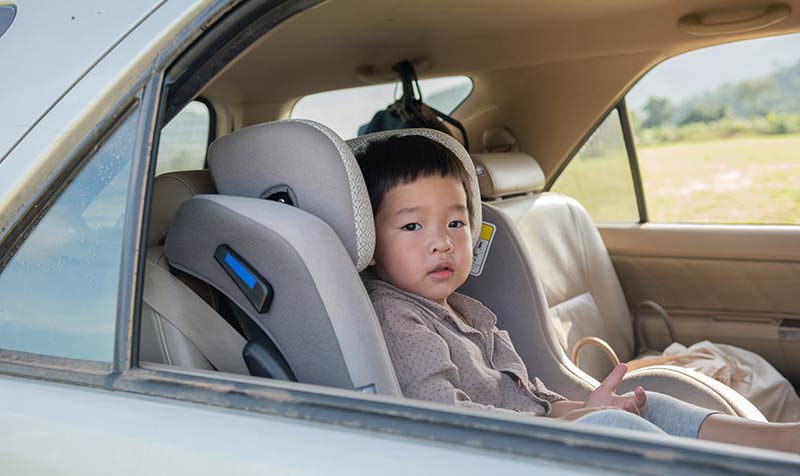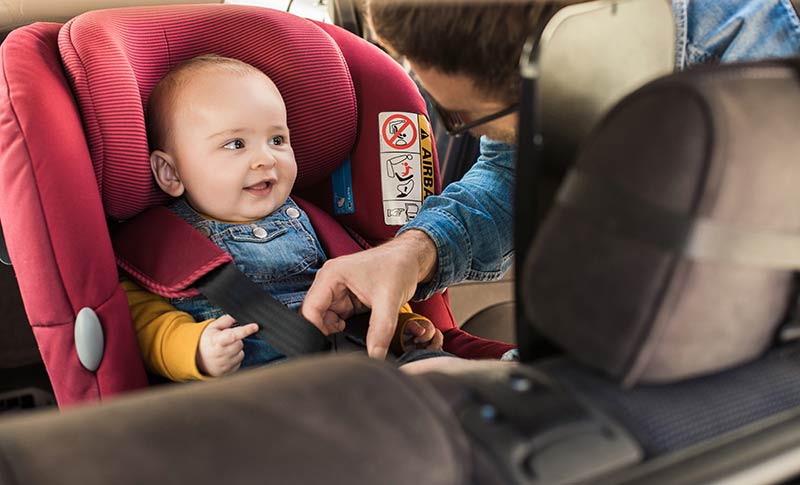The state of Kansas legally requires children under the age of 8 years old who are shorter than 4’9” and weigh less than 80 pounds to be secured in a child-restraint system.
Children under 4 years old must be secured in a child restraint system with an internal harness.
Car Seat Requirements Kansas

Rear-Facing Car Seat Law Kansas
There is no legal specification for how long a child must remain in a rear-facing car seat in Kansas.
Kansas law only states that children under 4 years old be secured in a car seat (with separate harness system).
However, the state does provide safety guidelines for when you should use a rear-facing car seat.
Rear-Facing Car Seat Guidelines Kansas
Kansas recommends keeping children rear-facing until they reach BOTH of the following requirements:
- Rear-Facing Car Seat Age: 1 year
- Rear-Facing Car Seat Weight: 20 lbs.
- Rear-Facing Car Seat Height: unspecified
Once a child reaches a year old and 20 pounds, the child may transition to a forward-facing car seat.
But it’s recommended to keep a child rear-facing as long as possible, until they reach the maximum height or weight limit on their rear-facing seat.
Forward-Facing Car Seat Law Kansas
Children must ride in a front-facing (or rear-facing) car seat in Kansas until they reach ONE of the following requirements:
- Forward-Facing Car Seat Age: 4 years
- Forward-Facing Car Seat Weight: 80 lbs.
- Forward-Facing Car Seat Height: 4’9”
Once a child reaches 4 years old, the child may transition to a booster seat.
But it’s recommended to keep a child in a forward-facing car seat (with separate harness) as long as possible, until they reach the maximum height or weight limit on the forward-facing seat.
Where can I get my car seat checked or installed in Kansas?
The Kansas Traffic Safety Resource Office maintains a map of Child Passenger Safety Inspection Stations in the state. (Unfortunately, as a map, it doesn’t work all that well.)
However, most inspection stations in Kansas are either at fire departments or police stations, and you can search your local fire or police department on the page above to see if they have any certified technicians on staff.
Olathe Medical Center also maintains a list of Child Passenger Safety Seat Fittings & Installations in Kansas City and surrounding areas.
General Car Seat Laws FAQ

Are car seats effective?
Yes. Very.
According to the CDC, “car seat use reduces the risk for injury in a crash by 71-82% for children, when compared with seat belt use alone.”
What’s the best car seat?
Different types of car seats (infant, convertible, etc.) have different uses.
But, no matter what type of car seat you’re using, the best car seat is the one that will do the most effective job of keeping your child safe in the event of an accident.
See Which Car Seat To Buy: Making Sure Your Little Ones Stay Safe On The Road for our recommendations.
How do you install a car seat?
Car seat installation varies depending on whether the seat is being installed rear- or forward-facing and the manufacturer of the seat.
For help installing a rear-facing car seat, see Passenger Safety For Babies at Safe Kids Worldwide.
And for help installing a forward-facing car seat, see Passenger Safety For Little Kids at Safe Kids Worldwide.
Does AAA do car seat inspections?
Yes, the American Automobile Association (AAA) has certified child passenger safety technicians on staff.
If you are a member of AAA, you can have your car seat installation inspected for free (when available in your area).
Go to AAA.com/carseats to make an appointment for inspection.
When were car seats invented?
Two precursors to car seats as we know them today were both invented in 1962. (Though, they weren’t available until the late-60s.)
The first of these seats, and the one most similar to the car seats we use today, had a Y-shaped harness and was rear-facing.
The seat was invented by British inventor (and mother) Jean Ames.
The second of these seats was metal-framed seat designed to face forward, and was invented by American inventor Leonard Rivkin.
Before that, the only type of child seat for cars were booster-style car seats, which simply lifted children higher in the seat, but had no safety features and had been manufactured since the 1930s.
When did car seats become mandatory?
Car seats became mandatory between 1978 and 1986.
Though car seats were available in the late 1960s, and the data showing their effectiveness was available in the early 1970s, they remained optional safety devices, and most parents didn’t opt to use them.
So, it became a matter of enacting laws.
In the U.S., car seats became mandatory as most things do – on a state-by-state basis.
In 1978, Tennessee became the first state to enact a child restraint law of any kind (the law passed in 1977), a successful campaign that prompted other states to follow suit.
Over the next few years, all U.S. states passed and implemented child restraint laws, with all states enacting laws by 1986.
Who is responsible for child restraint laws in the U.S.?
While there were experts and activists all over the country working to pass child restraint laws, Dr. Robert Sanders and his wife Pat are largely credited with getting the first Tennessee law passed.
Dr. Sanders was a pediatrician and he and his wife lobbied for the legislation for years.
Dr. Sanders even got a moniker out of his activism.
He became affectionately known as “Dr. Seat Belt.”
Car Seats Save Young Lives
Car seats are designed to protect the smallest, most vulnerable of children, and, since car seat rules first went into effect nationwide in the mid-1980s, they have done a stellar job at saving kids’ lives.
That’s why car seats are required in every state in the U.S. up to a certain age (with some states also having booster and front seat laws), and why the American Academy of Pediatrics and CDC recommend using some form of child restraint system in vehicles until children are big enough to be protected by a car’s built-in safety features (4’9”).
So, definitely follow Kansas’s car seat laws to protect the smallest of children.
And continue to follow the booster and front seat laws (or expert guidelines) to ensure your child is well-protected on the road.
For more on Kansas’s booster seat laws, see Kansas Booster Seat Laws.
For more on Kansas’s front seat guidelines, see Kansas Front Seat Law.
